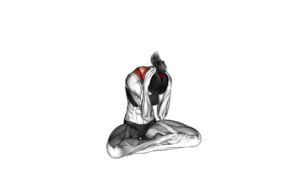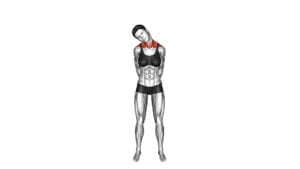Sitting Side Neck Stretch (female) – Video Exercise Guide & Tips

Are you looking for a simple and effective stretch to relieve tension in your neck? Look no further than the sitting side neck stretch!
Watch This Exercise Video
In this video exercise guide, we'll show you the proper form and technique to perform this stretch correctly. Plus, we'll share tips on how to maximize its benefits and common mistakes to avoid.
So grab a chair and get ready to improve your neck flexibility with this easy stretch.
Key Takeaways
- The Sitting Side Neck Stretch improves posture and provides tension relief in the neck and shoulder area.
- It counteracts the effects of long hours of sitting and using electronic devices.
- The exercise promotes better alignment of the spine and targets and releases built-up tension in the neck and shoulder muscles.
- Proper form and technique involve sitting in a comfortable position, tilting the head to the side without pushing or pulling, and holding the stretch for 20-30 seconds while breathing deeply.
Benefits of the Sitting Side Neck Stretch
You can experience several benefits by regularly performing the Sitting Side Neck Stretch. This exercise is highly effective in improving your posture and providing tension relief in the neck and shoulder area.
One of the main benefits of the Sitting Side Neck Stretch is improved posture. Many of us spend long hours sitting at a desk or using electronic devices, which can lead to poor posture and strain on the neck and shoulders. By incorporating this stretch into your routine, you can help counteract these effects and promote better alignment of the spine.
Additionally, the Sitting Side Neck Stretch provides tension relief. Tension in the neck and shoulder muscles is a common issue caused by stress, poor posture, and repetitive movements. This stretch specifically targets these areas, helping to release built-up tension and promote relaxation.
To ensure you get the most out of the Sitting Side Neck Stretch, it's important to practice proper form and technique. By maintaining a seated position with your spine straight, gently tilt your head to the side, bringing your ear towards your shoulder. Hold this stretch for 15-30 seconds on each side, while breathing deeply and focusing on releasing tension.
Proper Form and Technique for the Exercise
To ensure optimal results and prevent injury, it's essential to maintain proper form and technique while performing the Sitting Side Neck Stretch.
This exercise targets the muscles on the side of your neck and can help alleviate tension and improve flexibility.
To begin, sit in a comfortable position with your spine tall and shoulders relaxed.
Start by tilting your head to one side, bringing your ear towards your shoulder. Avoid the common misconception of pushing or pulling your head with your hand, as this can strain the neck. Instead, let the weight of your head provide the stretch.
Hold this position for 20-30 seconds, feeling a gentle stretch along the side of your neck. Remember to breathe deeply and relax your shoulders throughout the stretch.
To deepen the stretch, you can try alternative exercises such as gently adding a slight tilt of your chin towards the shoulder or using your hand to apply gentle pressure to the opposite side of your head. However, always listen to your body and never force the stretch beyond your comfort level.
Tips for Getting the Most Out of the Stretch
To maximize the benefits of the Sitting Side Neck Stretch, it's important to incorporate these tips into your routine. Stretching isn't only crucial for improving flexibility, but it also plays a vital role in injury prevention. Before engaging in any exercise, it's essential to stretch to warm up your muscles and prepare them for the upcoming physical activity.
Firstly, make sure to maintain proper form during the stretch. Sit upright with your back straight and shoulders relaxed. Keep your head aligned with your spine and avoid hunching forward. This will ensure that you're targeting the correct muscles and minimizing the risk of strain.
Secondly, take your time and breathe deeply throughout the stretch. Inhale deeply as you begin the stretch and exhale slowly as you deepen the stretch. This will help relax your muscles and increase your range of motion.
Additionally, listen to your body and avoid pushing yourself too hard. Stretch until you feel a gentle pull in the side of your neck, but never to the point of pain. Remember, stretching should feel good and not cause discomfort.
Lastly, be consistent with your stretching routine. Incorporate the Sitting Side Neck Stretch into your warm-up before each exercise session to reap the maximum benefits. Stretching regularly will gradually improve your flexibility and help prevent muscle imbalances and injuries.
Common Mistakes to Avoid During the Stretch
Maintaining proper form and technique is crucial to avoid common mistakes during the Sitting Side Neck Stretch. By following the correct technique, you can maximize the benefits of this exercise while minimizing the risk of injury.
One common mistake to avoid is pulling or tugging on your head or neck too forcefully. This can strain the muscles and potentially lead to discomfort or even injury. Instead, gently place your hand on the side of your head and apply a light pressure to increase the stretch.
Another mistake is allowing your shoulder to hike up towards your ear during the stretch. This can create tension in the neck and shoulder muscles, defeating the purpose of the exercise. Focus on keeping your shoulder down and relaxed, allowing the stretch to target the correct muscles.
Lastly, rushing through the stretch is another common mistake. Take your time and hold the stretch for the recommended duration, typically around 20-30 seconds. This will allow the muscles to fully elongate and improve flexibility.
Variations and Modifications for Different Fitness Levels
You can modify the Sitting Side Neck Stretch to suit your fitness level by adjusting the intensity and duration of the stretch. Variations and modifications are important because they allow you to customize the exercise to your specific needs and abilities.
Whether you're a beginner or an advanced fitness enthusiast, there are options available for you.
For beginners, it's recommended to start with a gentle stretch and gradually increase the intensity over time. You can begin by simply tilting your head to one side and holding the stretch for a few seconds. As you become more comfortable, you can increase the duration of the stretch and add a slight downward pressure with your hand to deepen the stretch.
If you're more advanced, you can try incorporating additional movements into the stretch. For example, you can tilt your head to the side and then rotate it in a circular motion, combining lateral flexion and rotation. This will target different muscles in your neck and provide a greater stretch.
Remember, the key is to listen to your body and not push yourself too hard. Stretching should feel good and not cause any pain. If you experience discomfort or pain, it's important to modify the stretch or consult with a professional for guidance.
Frequently Asked Questions
How Often Should I Perform the Sitting Side Neck Stretch?
To maintain flexibility and prevent muscle tension, it's recommended to perform the sitting side neck stretch regularly. By incorporating this stretch into your routine, you can improve range of motion and reduce any discomfort.
The frequency of this exercise depends on your individual needs and goals. It's advised to start with 2-3 times per week and gradually increase as tolerated.
Remember to always listen to your body and modify the stretch to suit your comfort level.
Can This Stretch Help With Relieving Tension Headaches?
Stretching techniques can be effective for providing alternative headache relief. By incorporating regular stretching into your routine, you may find that it helps to alleviate tension headaches.
This can be especially true for the neck and shoulder areas, where tension often accumulates. While the sitting side neck stretch is one option to consider, there are also other stretches that can target these areas and potentially provide relief.
It's important to experiment and find what works best for you.
Is It Safe to Perform the Sitting Side Neck Stretch if I Have a History of Neck Injuries?
If you have a history of neck injuries, it's important to take precautions when performing the sitting side neck stretch. Consult with a healthcare professional to determine if it's safe for you to do this exercise.
They may recommend alternative neck stretches that are more suitable for your condition. Remember to always prioritize your safety and listen to your body's signals during any exercise routine.
Can This Stretch Be Done While Sitting at a Desk or Should It Be Done in a Specific Position?
You can perform the sitting side neck stretch while sitting at a desk or in a specific position.
This stretch is versatile and can be done in various settings. However, it's important to maintain proper posture and alignment to ensure the effectiveness and safety of the stretch.
Make sure you're sitting upright with your shoulders relaxed and your spine aligned. This will help target the muscles in your neck and provide the intended benefits of the stretch.
Are There Any Specific Breathing Techniques That Should Be Used During the Sitting Side Neck Stretch?
During the sitting side neck stretch, it's important to focus on your breath. Take slow, deep breaths as you gently stretch your neck to the side.
Inhale deeply as you prepare to stretch, and exhale as you lean your ear towards your shoulder. This will help relax your muscles and deepen the stretch.
Conclusion
In conclusion, the sitting side neck stretch is a beneficial exercise for improving neck flexibility and relieving tension.
By following proper form and technique, individuals can maximize the benefits of this stretch.
Remember to listen to your body and avoid common mistakes that may compromise the effectiveness of the exercise.
Additionally, variations and modifications can be made to accommodate different fitness levels.
Incorporating this stretch into your routine can contribute to overall neck health and well-being.

Author
Years ago, the spark of my life’s passion ignited in my mind the moment I stepped into the local gym for the first time. The inaugural bead of perspiration, the initial endeavor, the very first surge of endorphins, and a sense of pride that washed over me post-workout marked the beginning of my deep-seated interest in strength sports, fitness, and sports nutrition. This very curiosity blossomed rapidly into a profound fascination, propelling me to earn a Master’s degree in Physical Education from the Academy of Physical Education in Krakow, followed by a Sports Manager diploma from the Jagiellonian University. My journey of growth led me to gain more specialized qualifications, such as being a certified personal trainer with a focus on sports dietetics, a lifeguard, and an instructor for wellness and corrective gymnastics. Theoretical knowledge paired seamlessly with practical experience, reinforcing my belief that the transformation of individuals under my guidance was also a reflection of my personal growth. This belief holds true even today. Each day, I strive to push the boundaries and explore new realms. These realms gently elevate me to greater heights. The unique combination of passion for my field and the continuous quest for growth fuels my drive to break new ground.







